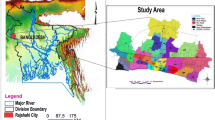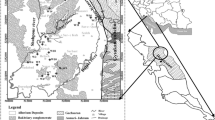Abstract
The chemical quality of groundwater of western Haryana, India was assessed for its suitability for drinking purposes. A total of 275 water samples were collected from deep aquifer based hand-pumps situated in 37 different villages/towns of Bhiwani region. The water samples were analyzed for different physico-chemical properties, e.g., pH, total dissolved solids (TDS), total harness (TH), total alkalinity (TA), calcium, magnesium, carbonate, bicarbonate, sulphate, chloride and fluoride concentrations. In this study, the average TDS content was greater ranging 1,692 (Bhiwani block) to 2,560 mg l−1 (Siwani block), and other important parameters of water, e.g., TA (442–1,232 mg l−1), TH (437–864 mg l−1) and bicarbonate (554–672 mg l−1), were also higher than maximum permissible limit by WHO or BIS. The fluoride appeared as a major problem of safe drinking water in this region. We recorded greater fluoride concentration, i.e., 86.0 mg l−1 from Motipura village that is highest fluoride level ever recorded for Haryana state. The average fluoride concentration ranged between 7.1 and 0.8 mg l−1 in different blocks of western Haryana. On the basis of fluoride concentration, Siwani block showed the maximum number of water samples (84% of total collected samples) unsuitable for drinking purposes (containing fluoride >1.5 mg l−1) followed by Charki Dadri block (58%), Bhiwani block (52%), Bawani Khera block (33%) and Loharu block (14%). This study clearly suggest that some health deteriorating chemicals in drinking water were at dangerous level and; therefore, water quality could be a major health threat for local residents of western Haryana. The high fluoride level in drinking water has posed some serious dental health risks in local residents.


Similar content being viewed by others
References
APHA–AWWA–WPCF (1994) Standard methods for the examination of water and wastewater, 15th edn. American Public Health Association, Washington DC
Bober J, Kucharska E, Zawierta J, Machoy Z, Chlubek D, Ciechanowski K (2000) The influence of fluoride ions on the viability, reduction of NBT, cytolysis, degranulation, and phagocytosis of human and rabbit neutrophils. Fluoride 33(3):108–114
Bureau of India Standard (BIS), (1991) Indian standard specification for drinking water. IS, 10500, pp 2–4
Chand D (2001) Proceedings of the international workshop on fluoride in drinking water: strategies, management and mitigation, Bhopal, 13–27
Chinoy NJ (2002) Studies on fluoride, aluminium and arsenic toxicity in mammals and amelioration by some antidites. In: Tripathi G (ed) Modern trends in environmental biology. CBS Publishers and Distributers, New Delhi, pp 164–193
Chlubek D, Poreba R, Machalinski B (1998) Fluoride and calcium distribution in human placenta. Fluoride 31(3):131–136
Durfor CN, Becker E (1964) Public water supply of the 100 largest cities in US. US-Geological Survey Water Supply Paper 1812, 364
Freni SC (1994) Exposure to high fluoride concentration in drinking water is associated with decreased birth rate. J Toxicol Environ Health 42(1):109–121
Joseph S, Gadhia PK (2000) Sister chromatid exchange frequency and chromosome aberration in residents of fluoride endemic regions of south Gujrat. Fluoride 33(4):154–158
Khaiwal R, Garg VK (2006) Distribution of fluoride in groundwater and its suitability assessment for drinking purposes. Int J Environ Health Res 16:166–169
Khaiwal R, Garg VK (2007) Hydro-chemical survey of groundwater of Hisar city and assessment of defluoridation methods used in India. Environ Monit Assess 132(1–3):33–43
Kaushik A, Kumar K, Sharma IS, Sharma HR (2002) Groundwater quality assessment in different land use areas of Rohtak and Faridabad cities of Haryana using deviation index. J Environ Biol 25:173–180
Kaushik A, Kumar K, Sharma IS, Sharma HR (2004) Assessment of ground water quality of Rohtak and Faridabad cities by deviation index. J Environ Biol 25(2):173–180
Lu Y, Sun ZR, Wu LN, Wang X, Lu W, Liu SS (2000) Effect of high fluoride water on intelligence in children. Fluoride 33(2):74–78
Machalinski B, Zejmo M, Stecewice I, Machalinski A, Machoy Z, Ratajczak MZ (2000) The influence of sodium fluoride on the clonogenecity of human hematopoietic progenitor cells: preliminary reports. Fluoride 33(4):168–173
McCarthy MF (2004) Should we restrict chloride rather than sodium? Med Hypothesis 63:138–148
Meenakshi, Garg VK, Kavita, Renuka, Malik A (2004) Groundwater quality in some villages of Haryana, India: focus on fluoride and fluorosis. J Hazard Mater 106B:85–97
Mor S, Bishnoi M, Bishnoi NR (2003) Assessment of groundwater quality of Jind city. Indian J Environ Protection 23:673–679
Nash H, McCall GJH (1995) Groundwater quality 17th special report. Chapman and Hall, London
Rabinove CJ, Long Ford RH, Brook Hart JW (1958) Saline water sources of north Dakota. US Geological Survey Water Supply Paper 1428, 72
Raja-Reddy D (1979) Hand book of neurology. North Holland Publishing Co, Amsterdam, p 465
Sanchez-Perez JM, Tremolieres M (2003) Changes in groundwater chemistry as a consequence of suppressions of floods. The case of Rhine floodplains. J Hydrol 270:89–104
Shivashankara AR, Shivaraja Shankara YM, Rao SH, Bhat PG (2000) A clinical and biochemical study of chronic fluoride toxicity in children of Kheru Thanda of Gulburga district, Karnataka, India. Fluoride 33(2):66–73
Suthar S, Garg VK, Sushma S, Jangir S, Kaur S, Goswami N (2007) Fluoride contamination in drinking water in rural habitations of Northern Rajasthan, India. Environ Monit Asses 145(1/3):1–6. doi:10.1007/s10661-007-0011-x
Takahashi K (1998) Fluoride-linked Down Syndrome births and their estimated occurrence due to water-fluoridation. Fluoride 31(2):61–73
UNICEF (1999) States of the art report on the extent of fluoride in drinking water and the resulting endemicity in India. Report by Fluorosis and Rural Development Foundation for UNICEF, New Delhi
USPHS (United States Public Health Services) (1962) Drinking water standards. USPHS publication 956, USGPO, Washington DC
WHO (World Health Organization) (1996) Water and sanitation facts sheets. N112. http://www.who.int/inf-fs/en/fact112.html
WHO (World Health Organization) (1997) Guideline for drinking water quality health criteria and other supporting information, vol. 2, 2nd edn. Geneva
WHO (World Health Organization) (2001) Water health and human rights, world water day. http://www.woldwaterday.org/thematic/hmnrights.html#n4
WHO (World Health Organization) (2006) Fluoride in drinking water. IWA Publishing, London, p 144
WHO (World Health Organization) (2007) Chemical Safety of drinking water: assessing priorities for risk managements. WHO, Geneva, p 160
Author information
Authors and Affiliations
Corresponding author
Rights and permissions
About this article
Cite this article
Garg, V.K., Suthar, S., Singh, S. et al. Drinking water quality in villages of southwestern Haryana, India: assessing human health risks associated with hydrochemistry. Environ Geol 58, 1329–1340 (2009). https://doi.org/10.1007/s00254-008-1636-y
Received:
Accepted:
Published:
Issue Date:
DOI: https://doi.org/10.1007/s00254-008-1636-y




